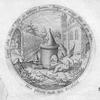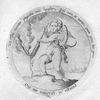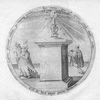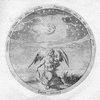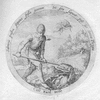Et piu dolsi [15]
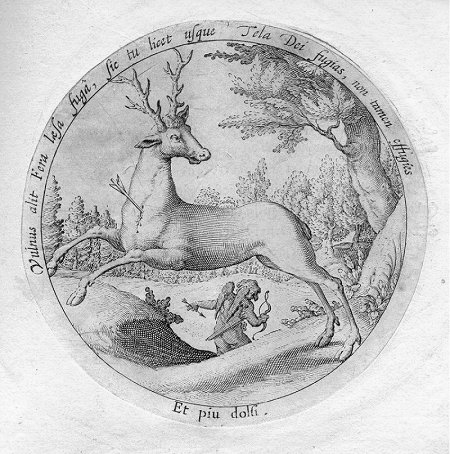
Ick die zoo menigh strick/ zoo menigh groote hoopen1
Van Jaghers toegherust2 end’ honden ben ontloopen/
Een hevet my ghedaen3/ het4 cleeft my in het hert/
Hoe snel dat ick oock loop/ noch snelder is mijn smert.
Ick ben nu ver ghenoech ontcomen ’s vyandts handen/
Ick loop’/ ick vlieg’/ ick ren/ door bosschen ende landen/
Die my quetst is van hier5/ ick hebb’ van haer gheen noodt/
Maer niet te min is zy de oorsaeck van mijn doodt.
Van Jaghers toegherust2 end’ honden ben ontloopen/
Een hevet my ghedaen3/ het4 cleeft my in het hert/
Hoe snel dat ick oock loop/ noch snelder is mijn smert.
Ick ben nu ver ghenoech ontcomen ’s vyandts handen/
Ick loop’/ ick vlieg’/ ick ren/ door bosschen ende landen/
Die my quetst is van hier5/ ick hebb’ van haer gheen noodt/
Maer niet te min is zy de oorsaeck van mijn doodt.

Translations
 |
Het doet meer pijn. |
 |
It hurts more. |
 |
Een gewond dier op de vlucht voedt zijn wond; zo zul jij, al vlucht je steeds voor de pijlen van de god, die niet ontvluchten. |
 |
By fleeing a wounded animal aggravates its wound; thus by constantly fleeing the arrows of the god you will not escape them. |
Literature
-
Henkel and Schöne, Emblemata
 , col. 472
, col. 472
-
Praz, Seventeenth-Century Imagery
 , p. 95
, p. 95
Sources and parallels
- Same emblem in 1601 edition: Et piu dolsi [15] (in: Daniël Heinsius, Quaeris quid sit Amor (c. 1601))
[Compare
![Compare [compare]](/static/images/compare2.gif) ]
]
- Source for the motto: Petrarca, Canzoniere
 , poem. 209, 11
, poem. 209, 11 - Source for the pictura and entire emblem: Junius, Emblemata [web]
 , embl. 47
, embl. 47 - Parallel for the pictura and entire emblem (with Junius as shared source?): Rollenhagen, Nucleus emblematum selectissimorum
 , bk/embl. II/56
, bk/embl. II/56
- A probable adaptation: Ille fuga silvas saltusque peragrat [15] (in: Otto Vaenius, Amorum emblemata (1608))
[Compare
![Compare [compare]](/static/images/compare2.gif) ]
]
-
Parallel in the 1616 edition: motto and subscriptio the same, pictura is mirrored and departs slightly (Cupid seen
from the front): Et piu dolsi. [39] (in: Daniël Heinsius, Ambacht van Cupido, from: Nederduytsche poemata (1616))
[Compare
![Compare [compare]](/static/images/compare2.gif) ]
]
References, across this site, to this page:
- Un Cerf blessé d’une fleche (in: Daniel de la Feuille, Devises et emblemes (1691))
- Et piu dolsi [15] (in: Daniël Heinsius, Quaeris quid sit Amor (c. 1601))
- Et piu dolsi. [39] (in: Daniël Heinsius, Ambacht van Cupido (1613))
- Et piu dolsi. [39] (in: Daniël Heinsius, Ambacht van Cupido, from: Nederduytsche poemata (1616))
- Ille fuga silvas saltusque peragrat [15] (in: Otto Vaenius, Amorum emblemata (1608))
- Ille fuga silvas saltusque peragrat [15] (in: Otto Vaenius, Amorum emblemata (1608))
Iconclass
A deer running away from Cupid who has shot an arrow in his chest- hoofed animals: deer (+ running animal)
[25F24(DEER)(+5212)]

- hoofed animals: deer (+ animal(s) being hit, shot, caught)
[25F24(DEER)(+621)]

- low hill country
[25H114]

- forest, wood
[25H15]

- 'Fuga', 'Fuga popolare', 'Persecutione' (Ripa)
[33B90]

- stag-hunting
[43C111241]

- archer's weapons: arrow
[45C15(ARROW)]

- Pain, Sorrow, Sadness; 'Dolore', 'Dolore di Zeusi' (Ripa) (+ emblematical representation of concept)
[56BB1(+4)]

- (personifications and symbolic representations of) Love; 'Amore (secondo Seneca)' (Ripa) (+ emblematical representation of
concept)
[56F2(+4)]

- proverbs, sayings, etc. (with TEXT)
[86(ET PIU DOLSI)]

- Cupid handling his weapons
[92D152]

![[H O M E : Emblem Project Utrecht]](/static/images/rd-small.gif)




